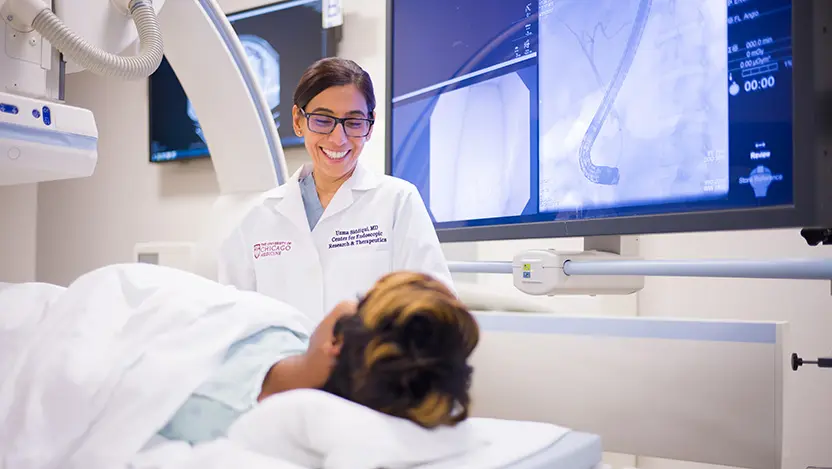Can large colon polyps be removed without surgery?

Uzma Siddiqui, MD, is the director of the Center for Endoscopic Research and Therapeutics at UChicago Medicine.
Not all colon polyps can be removed during a routine colonoscopy. Larger colon polyps are more difficult to remove, and require a specialist. If a routine colonoscopy screening reveals you have large colon polyps, your doctor may recommend that you have surgery.
However, a less-invasive, endoscopic option exists for treating these growths in the colon. Gastroenterologist and therapeutic endoscopist Uzma Siddiqui, MD, specializes in performing endoscopic mucosal resection (EMR), a leading-edge procedure that allows for the removal of large colon polyps without surgery.
Using this technique, Siddiqui has removed thousands of colon polyps through a scope. With EMR, most benign colon polyps of any size can be safely and effectively removed.
What sort of colon polyps are usually removed using endoscopic mucosal resection (EMR)?
Any polyp can be removed using this technique, but usually it is used for large or “giant” polyps that are more than 2 centimeters in size. These larger polyps typically occur on the right side of the colon or in the rectum. They account for about 5% of all colon polyps found during colonoscopies. The vast majority of these large growths are benign.
Endoscopic mucosal resection is a procedure that allows for the removal of large colon polyps without surgery.
How does endoscopic mucosal resection work?
With EMR, a colonoscope — this is a long, thin black tube with a camera on the end of it — is inserted into the anus and advanced to the polyp. The colonoscope has an accessory channel that allows various small instruments to be passed through it so they can be used to remove the polyp. The polyp is injected with liquid to help lift it off of the colon wall, which helps prevent a hole or perforation during removal.
Doctors then use a snare, which is like a small metal lasso, to grab the polyp. Heated energy is then applied to cut it off. We use a small net to grab the polyp once it has been cut off so that we can send it to the pathologist to examine.
How long does it take to recover from EMR?
From the patient perspective, a colonoscopy with EMR should feel the same as a typical screening colonoscopy. At the Center for Endoscopic Research and Therapeutics (CERT), all of our patients undergoing the procedure receive monitored anesthesia care from a dedicated anesthesia team. Depending on the size and location of the polyp, and whether it has significant scar tissue because of a prior manipulation, it usually takes about an hour or less to remove.
There are no external incisions and patients can go back to their normal activity the day after their procedure. Because there’s a roughly 20% chance of having left-over polyp tissue, it’s important for patients to return for a checkup colonoscopy six to 12 months after their endoscopic mucosal resection.
What if a polyp is suspected of being cancerous?
Polyps that are adenomas or tubulovillous adenomas are benign, but have the potential to become cancerous. These tumors are great candidates for EMR removal, and they’re typically removed in multiple pieces when they’re large. But if there is any concern regarding early-stage cancer — and this happens more often with tumors in the rectum — it’s important to try and remove the polyp in one piece.
To do this, we use another colonoscopy technique called endoscopic submucosal dissection (ESD). Instead of using a snare, we use a small blade the size of a pen tip to cut the tissue and remove the polyp in one piece. This increases the likelihood of removing all of the cancerous cells. This procedure is only for early-stage cancer, however. Invasive cancer that reaches deeper into the colon wall often involves the lymph nodes and for that, patients will need surgery.
How safe is endoscopic mucosal resection?
EMR is known to be very safe in general, but as with every medical procedure, there are some risks. There can be up to a 20% chance of delayed bleeding after the procedure, especially if a patient has a large right colon polyp removed or has to go back on blood thinner medication.
We use different techniques to prevent delayed bleeding, including cauterizing and small clips to close off blood vessels. If there is significant bleeding, it can be treated with a second-look colonoscopy to treat any visibly bleeding blood vessels.
There’s also a remote chance of perforating the colon wall during EMR. The more a polyp has been manipulated — whether that’s by being biopsied, marked with a tattoo, or partially removed in the past — the more scar tissue builds up and the more challenging the polyp is to remove. We work to avoid this complication by using smaller-sized snares and by carefully examining the area where the polyp was removed.
Endoscopic removal of large colon polyps is a technically challenging procedure that requires precision and skill. That's why it's so important to ensure your endoscopist has expertise in this area.

Uzma Siddiqui, MD
Dr. Siddiqui is a gastroenterologist with expertise in interventional endoscopy. Her clinical focus is on gastrointestinal oncology and endoscopic ultrasound (EUS).
See Dr. Siddiqui's physician profile
Endoscopic Mucosal Resection Patient Story
During a routine colonoscopy, Ron McCormick's gastroenterologist identified two large polyps that needed expert removal. A family friend recommended the University of Chicago Medicine.
Read Ron's story